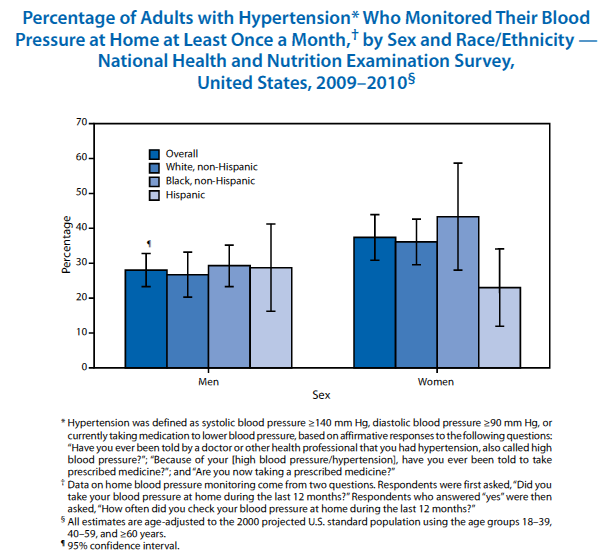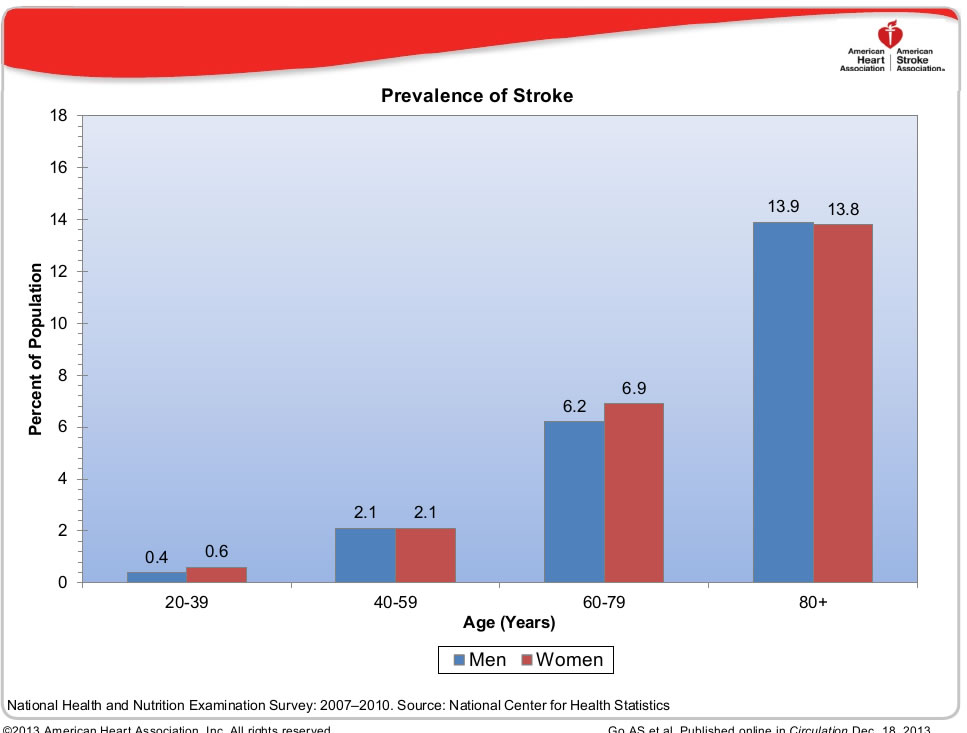Hypertension and Stroke
Review CDC Web page on hypertension and look at the right-hand centre for facts and statistical reports and maps with basic information on incidence, prevalence, and distribution. Look at this data brief from NCHS on hypertension, is prevalence and treatment outcomes for 2012 What are the barriers to obtaining useful data for either research or public health intervention? How well do patients adhere to their prescriptions? Consider this data from the CDC on disparities and high blood pressure and think about how we might reduce them. Hypertension Prevalence and Control among Adults: United States, 2011-2014 there is a lot of very useful data in this publication. Also look at this editorial from the January 10, 2017, issue of JAMA looking at the global issue of high blood pressure. Also this new app from,the CDC on Stroke death trates
Student PowerPoint Presentation
Image from Nov 15, 2013, MMWR

From the required Textbook review Chapter 11. Review Figure 11.1 and consider how many of the risks and causes are similar to the other topics in this course. Do you think the changing parameters of the high blood pressure limits (upper & lower) affect how we intervene to maintain health or reduce disease? How would you rate the significant of the burden of disease associated with this condition to other major chronic diseases? how do you think the Framingham study has served as a translational method of intervening for this problem? When you look at pictures 11.2 and 11.3 how how much you believe race and sex contribute to this problem, and you think this is a genetic, environmental, or cultural problem, or a combination of all three? You think the geographic trends are linked to poverty or occupation and if so does this provide opportunities for translational research. As you work your way through the chapter think carefully about the role of individual prevention [clinical care] and population interventions. Think about the role of primary versus secondary prevention. Also review the section in chapter 13 starting at page 400 on cerebrovascular disease. Look at where the data comes from and be prepared to discuss why there is a "stroke belt" in the Southeast. You think hypertension atherosclerosis or a combination are the most important predecessors of stroke? Where would you intervene? Do you think diabetes plays a role in cerebrovascular disease? Can you think of areas of population research other than those recommended on page 408?
The following articles should help you think a little more about the importance of the definition of a diagnosis, as well as the value of intervening and when intervention should take place if at all.
The first article, to treat or not to treat may help you understand the problem of definitions and the difficulties of intervention and potential harm. See the box at the conclusion of this short essay.
The second, an editorial on cholesterol from JAMA is worth reviewing and again makes the point that guidelines are just that and should not be an absolute requirement but need to be tempered by caution.
While this viewpoint article discusses the problem of unrecognised hypertension and practice and suggests how to manage it. Bearing in mind the two previous discussion.
This editorial from the New England Journal should also raise doubt on Importance of modifying salt Intake, which continues to be controversial when discussing hypertension.
This article on global sodium consumption and its relation to cardiovascular disease is quite interesting and shows that consumption covers a relatively broad range of intake although it is an analysis of association not a double-blind study.
Then this editorial from JAMA on declining incidence of stroke is interesting in suggesting future challenges to improve success when treating/as well as preventing it. Remember that assumptions that look 15 to 20 years ahead are just that and intervening changes in practice is likely to override these assumptions.
Hypertension Care from AHRQ. Take a look at the NICE issues 1(one) and (two).
Feb 2010 Report of IOM on Hypertension: A Population-Based Policy and Systems Change Approach to Prevent and Control Hypertension. Rather than trying to read the entire material click on the PDF download link and select the chapters, then scan the summary and chapter 5 which focused on individuals. Review the summary and consider the research on which the report is based. Scan Chapters 2, 4, 5, & 6.

The Stroke Association released its latest guidelines on stroke prevention in Dec 2010 Stroke Recommendation (In looking at stroke statements and guidelines guidelines for primary prevention -Don't try to read the whole thing but take a look at tables 1 through three and take a quick scan of the rest so you know what is included.. And scan any other statements you wish to view). Also look at the first two 2013 statements on the stroke on the guidelines page relating to an updated definition of stroke and forecasting of future strokes in the US. The Stroke Association has numerous guidelines which you can look at the supplement the first publication.See the CDC update on its stroke guidelines page, In particular take a look at the Atlas, the second item on the page. You may want to scan these before discussing the issues in class. Do you believe that strokes in the elderly ( Look at their definition of elderly! I would add another ten years to the age) can be averted by treating HBP? What about memory loss? Look at this summary on progress in stroke treatment from Medpage, then look at the Mr Clean trial, Prime Trial, and the REVASCAT trial and consider how good the studies were.
Learn how to use “Health Data Interactive” When you get to the page select health conditions in the table topics section then choose chronic conditions and look at the four columns on cardiovascular disease look at how age and income are associated. Why do you think economic circumstances make such a difference?
Review the stroke Home Page at CDC, as well as pages 7-9 from the Framingham study on 'Stroke Risk'.
Do you find the Maps and Statistics page useful? Why?
Visit the NIH Neurological Disorders & Stroke Strokesite.You find any information here different from the other sites? Which of the various site you visited you find the most useful and helpful considering the distribution of disease by age, sex, race and geography?
Visit NIH Heart & Vascular Disease web site. Examine information available for hypertensions and peripheral vascular disease.Look at the material specific to high blood pressure. Finally revIeiw this recent article from the Lancet
Pattern of higher blood pressure in early adulthood helps predict risk of atherosclerosis in middle age
BP management Early Ischemic stroke
Protocol-Based Treatment of Hypertension (Interesting that this was in the Wall Street Journal, which shows that good journalists really can help with useful articles on health conditions.)
Trustworthiness of the Guidelines for Management of High Blood Pressure in Adults
Just to add to the confusion: What Are the Right Goals and Purposes?and this recent article on effects of HBP and outcome of treatment.
The most recent release, 2015 on Heart/Stroke Statsistics from AHA, The centre section on stroke statistics and support materials are well worth looking at. as well as this coiment on the value of insurance.
a great Ted talk regarding experiencing a stroke first hand..
